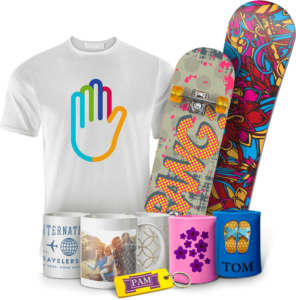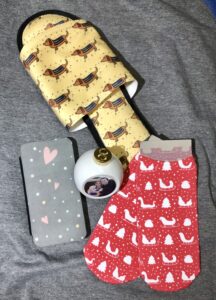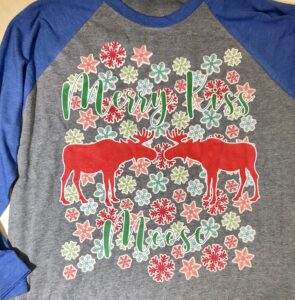During the holidays, there’s something magical about receiving a personalized gift. It brings up feelings of appreciation and thoughtfulness, and as the receiver, you know that gift was hand-picked for you. According to market forecasts, the personalized gifting trend is here to stay, and is estimated that the global personalized gift market is set to increase considerably over the coming years. In fact, it is projected to grow to over $38 billion by 2027.
Because of the expected industry growth, more businesses will need printing solutions to create these personalized gifts quickly and effectively. Dye-sublimation printing is an ideal solution to effectively produce custom gifts, and the technology is offered in both entry-level desktop and wide-format production sizes, perfect for both small businesses and large service providers to easily and confidently create custom gifts that anyone would be happy to give or receive.
For print shop providers (PSPs) of all sizes preparing for the upcoming holiday season and looking to expand personalization capabilities, dye-sublimation technology can make it easy to create a variety of personalized gifts without the need to expand shop space or a grand learning curve. Moreover, purchasing and installing this technology is a relatively seamless process when you have access to details about the equipment required, printing and transferring processes, as well as the types of output and gifts that can be printed and sold.

The equipment: Selecting a printer for success
Dye-sublimation technology has been rapidly advancing over the years. Traditionally, installation required PSPs to invest in large equipment, including the production of wide-format printers larger than 44″ and bulky heat transfer technology. As the technology evolved, so did desktop printer offerings ranging from 8.5″-24″. With this, manufacturers now meet the needs of smaller, independent shops as well as production environments looking to install a fleet of smaller solutions.
In addition to a smaller size, manufacturers have found more effective ink and consumable solutions designed to help businesses increase ROI. Ink plays a major role in a printing business and its ability to create sellable, quality output. When looking for a dye-sublimation system, consider the ink technology and research local and federal regulations when selling textiles and apparel. There are different regulating parties; for example, OEKO-TEX’s ECO PASSPORT certification is one testing recognition that certifies inks are not harmful to human health. This is essential when creating apparel, especially for infants and children.
Also, new bulk ink delivery systems streamline the process by requiring less downtime to refill. In lieu of traditional ink cartridges, some newer printer solutions now offer high-capacity ink bottles that get poured into the permeant ink tanks in the printer. A few of these models include windows into the ink tanks so users can see the exact levels of ink available. Bulk ink systems can reduce plastic waste by leveraging bulk ink bottles and no longer require PSPs to hold onto ink cartridges for special recycling.
These new turnkey solutions in the market come equipped with the hardware and consumables to deliver fast, high-performance printing right out of the box. Coupled with workflow software, their smaller footprint is ideal for PSPs looking to start or expand production of personalized gifts and offer ornaments, holiday stockings, holiday T-shirts, baby onesies, or themed socks.
Printing process: creating gifts

Dye sublimation can be a quick and easy process with a little practice and the right equipment. In addition to the printer, the process requires heat transfer technology. Sold separately, there are a variety of heat transfer solutions available that range in size, price, and even specialty. For example, there are heat presses designed for coffee mugs and hats, and there are flat presses ranging in size for creating small ornaments to hoodies and sweatshirts. It’s up to the PSP to create a customized process designed to best suit their needs based on product offerings and scalability.
The dye-sublimation process involves printing the design onto transfer paper, which is later applied directly to the personalized gift. Retailers can provide customers with the ability to select a specific design, and then customize that design with names, dates, milestone moments, or more to create a personalized gift. As an example, customers can add wedding dates, graduation dates, or names to a holiday ornament to make a truly special gift.
The dye-sublimation process has several components:
- Print details: Print out the design and trim the excess transfer paper. If the gift is requiring a full bleed, allow the color to go all the way to the edge of the object without any additional white space.
- Apply to the gift: Using heat transfer tape for smaller items, place the print where it should be transferred. The main purpose of the tape is to prevent ghosting or any shifting of the image during the heat transfer process. The tape works with a variety of textures, including fabrics and rigid materials, and can often be reused multiple times.
- Heat transfer: Move the item to the heat transfer system. For the majority of transfers, it’s best to ensure there’s a barrier between the heat press and the print. Placing craft paper below the item will catch any ink runoff for full bleed items, and placing parchment paper on top of the item will prevent burning. Press the heat onto the item. Each heat transfer system and item will require a different temperature; however, it’s recommended to stay around 400 F.
- Finish: After applying heat, remove the tap, peel the transfer paper back, and the finished product is ready.
Dye-sublimated products are fast drying, so there can be a quick turnaround time, and with the majority of heat presses, there’s no wait time required in between products. With one small dye-sublimation printer and heat press, a small print shop can create many promotional gifts a day, whereas a larger shop with a fleet of smaller dye-sublimation printers can easily create hundreds of custom products within hours.
Offering custom gifts

Dye-sublimation is a very versatile printing method that can not only easily expand a business’s offerings for the upcoming holiday season but also year-round. When coupled with the correct heat press equipment, a print shop is capable of rapidly expanding product offerings that provide customers with a wide range of personalized gifts for the holiday season and for cherished moments throughout the year.
Popular dye-sublimation gifts for the holiday season can include personalized holiday stockings, ornaments, or holiday tree skirts. Additionally, oven mitts, tea towels, coasters, and mugs make great stocking stuffers, and customers can personalize them with favorite sayings, family members’ names, milestones, and more.
Throughout the year, the opportunities are endless with gifts such as custom laptop bags, tote bags, wood décor photo panels, smartwatch bands, and award plaques. These gift items are not only great during the winter months but also make great gifts for Mother’s and Father’s Day, as well as bridal showers, weddings, and graduation gifts.
Wrapping up
Dye-sublimation printing can be a great solution for businesses of all sizes. The scalable technology can provide solutions for a variety of print shop setups, including a single-person online craft business, a screen-print shop looking to expand product offerings, or a large shop looking for a cost-effective way to scale the business and find success during the busy holiday season.




